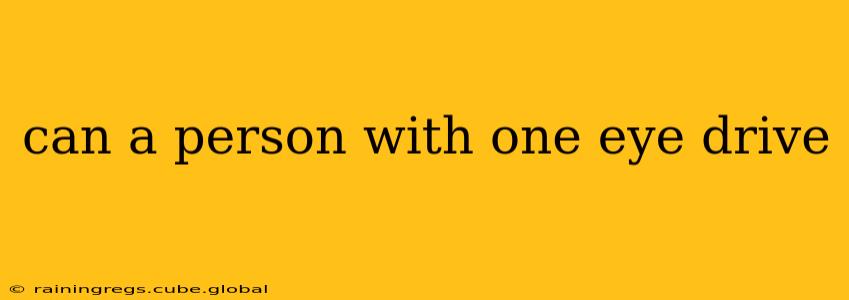Losing an eye can be a significant life event, raising many questions about everyday activities, including driving. The ability to drive with one eye depends on several factors, and the answer isn't a simple yes or no. This guide explores the legal and practical aspects of driving with monocular vision.
Is it Legal to Drive with One Eye?
The legality of driving with one eye varies significantly depending on your location. Most countries and states don't outright prohibit driving with one eye, but they do require drivers to meet certain vision standards. These standards often involve visual acuity, field of vision, and depth perception tests. It's crucial to check with your local Driver and Vehicle Licensing Agency (DVLA) or Department of Motor Vehicles (DMV) for specific requirements in your area. They'll assess your individual case and determine your eligibility to drive based on your remaining vision.
What Vision Tests Are Involved?
Driving with one eye often necessitates passing stricter vision tests than those required for individuals with binocular vision. These tests typically assess:
- Visual Acuity: This measures how clearly you can see at various distances. While a certain level of acuity is required for both eyes individually, monocular drivers often need higher acuity in their remaining eye to compensate.
- Field of Vision: This refers to the entire area you can see while looking straight ahead. A reduced field of vision, even in the remaining eye, can impact driving safety. Tests assess peripheral vision to ensure sufficient awareness of surroundings.
- Depth Perception: This crucial ability allows you to judge distances accurately. With binocular vision, both eyes work together to create a three-dimensional view. While monocular drivers can still perceive depth, they may do so with less precision and often rely on other cues like relative size and motion parallax. This aspect is rigorously tested during the driving assessment.
Can Depth Perception Affect Driving with One Eye?
How Depth Perception Works with One Eye
Depth perception, crucial for judging distances accurately while driving, relies heavily on binocular vision. However, individuals with monocular vision utilize various cues to compensate, including:
- Relative Size: Objects closer appear larger than those further away.
- Motion Parallax: As you move, closer objects appear to move faster than those further away.
- Linear Perspective: Parallel lines converge in the distance.
- Shading and Shadows: These give clues about the shape and distance of objects.
While these cues allow for depth perception with one eye, the accuracy is typically lower than with two eyes. This can pose challenges in situations requiring precise distance judgment, such as merging into traffic or parking.
How to Compensate for Reduced Depth Perception
Drivers with monocular vision often develop compensatory strategies to navigate these challenges. These strategies include:
- Increased attention to detail: Carefully observing surrounding vehicles and traffic signals.
- Slower driving speeds: Allowing more time to react and make driving decisions.
- Avoiding hazardous conditions: Opting for well-lit roads and avoiding driving in adverse weather conditions.
- Increased reliance on mirrors and turn signals: Utilizing these safety features to improve awareness of the surroundings.
What are the Challenges of Driving with One Eye?
Driving with one eye presents certain challenges compared to driving with two eyes. These include:
- Reduced peripheral vision: This can result in a smaller area of visual awareness.
- Slightly decreased depth perception: Although still possible, judging distances accurately may be more challenging.
- Increased need for concentration: Drivers may need to focus more intensely to compensate for reduced visual information.
- Difficulty in judging speed and distance of approaching vehicles: This is particularly challenging at night or in low visibility.
What are the Alternatives to Driving?
If driving with one eye proves too challenging or is deemed unsafe, alternative transportation options such as public transportation, ride-sharing services, or relying on family and friends for transportation should be considered.
This information is for general knowledge and should not be considered medical or legal advice. Always consult with your doctor and your local DMV for personalized guidance on driving with monocular vision. Your safety and the safety of others on the road are paramount.
